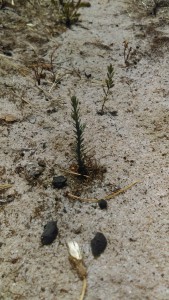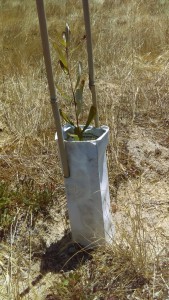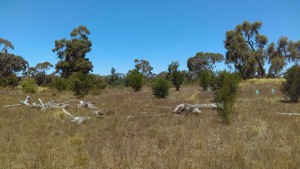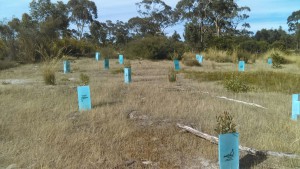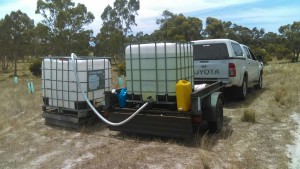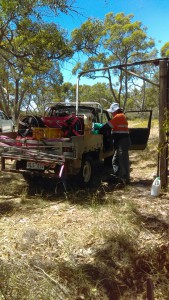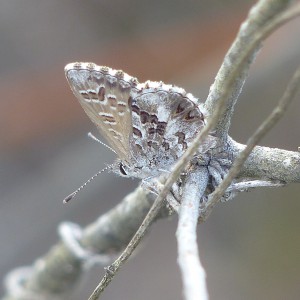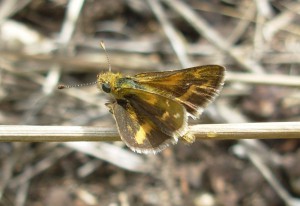Eaglehawk Waterhole – February 2018 Update
Our last Eaglehawk update was back in October 2017, where we reported on a successful day with the SE Association of Field Naturalists campout (link). An exciting component of our restoration efforts is seeing things we haven’t seen before like wildflowers emerging on the wet flats, rare birds using burnt areas and new plant or animal species to the reserve.
This update is highlighting changes in growth of vegetation, and health and safety on Eaglehawk Waterhole.
Greening Australia Victoria
Other organisations have also been contributing to revegetation at the reserve for their own project requirements, something which we are more than pleased to accommodate. Greening Australia Victoria has taken on the SW corner of the property with direct seeding and tubestock plantings in 2017. Andy, our caretaker, has snapped a few photos to show how that is progressing. We thank Jess Gardner and the GA Vic team for contributing to our whole of property restoration, and hope this year’s planting – of mostly stringybarks which will compliment previous efforts – establishes successfully.
Landscape Links
The Landscape Links project (coordinated by Cassie Hlava, NRSE) has also been instrumental in transforming the front of the reserve. In the first year you couldn’t miss the sea of tree guards. Well, you should see it now! A few more photos from Andy show off the success of this site below.
As highlighted in previous blog posts, piles of logs around the property have harboured rabbits and sometimes weeds. We have successfully re-purposed many of these logs, by scattering them throughout revegetation areas to create valuable woody debris habitat.
Complimenting this habitat creation has been the planting of a great diversity of species in their own little niches as required (damp areas or dry areas, etc). So we look forward to seeing what fauna these spots attract in the future.
We are sorry to see the Landscape Links program come to an end, but hope a new version of the same type of project emerges in the future. From all of us at NGT, well done Cassie!
20 Million Trees
Our own efforts through a 20 Million Trees grant has also seen a large chunk of the reserve’s vegetation improving in diversity and cover. Watering was the key in the first year to ensure a high survival rate and our watering system seemed to work well with a couple of 1000 L tanks dotted over the place where needed. Until recently, filling them has been problematic but late last year Andy and Sam, with help from Peter Haywood’s engineering experience, installed a safer and more efficient system. The team welded up a new A-frame to hold a pipe which carries water from the large tank on site to a quick fill pipe which can then fill portable tanks.
NGT was recently successful in obtaining another 20 Million Trees grant to continue our restoration effort at Eaglehawk, so preparation for more revegetation is rapidly moving along. Seed collecting is underway, with wattles collected back in Dec-Jan , and we’re now set to collect Tea-tree along with a bunch of other species in readiness for a late autumn sowing by Eucaleuca Native Services (Ralph Scheel). Weed control has commenced during January with a large area of Skeleton Weed spraying undertaken by Bush Repair (thanks Ken). Our new ‘you-beaut’ quick fill system has worked a treat for filling up the spray unit recently. Salvation Jane has also been on Andy’s radar with many hours of volunteer work undertaken to reduce the cover of this plant throughout the reserve.
New butterfly species to the reserve
During the past six months, Andy has found several new butterflies in the reserve including White-banded grass-darts, Fringed and Blotched Blues. The larvae of Grass-darts feed on native and introduced grasses, while the caterpillars of the Fringed Blue feed on shrubby peas like Daviesia, Pultenaea, and Bossiaea. The Blotched Blue is a fan of Cassytha (Dodder-laurel) which is a native and parasitic plant. Interestingly, the larvae of both the Blues eat the flowers of their host plants, which is unusual for caterpillars.
Thank you to all local organisations, staff and volunteers that help us with our restoration program at Eaglehawk Waterhole. NGT would also like to thank the Australian Government and the National Landcare Program for their continued support for our conservation and restoration work.

